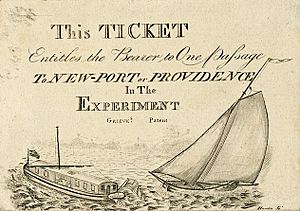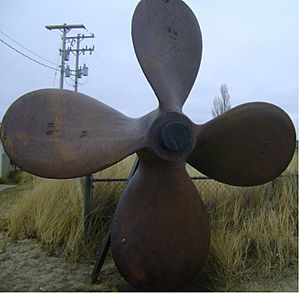Experiment (horse-powered boat) facts for kids

Experiment
|
|
Quick facts for kids History |
|
|---|---|
| Name | Experiment |
| Builder | David Wilkinson |
| General characteristics | |
| Tonnage | 12 |
| Length | 100 ft (30.48 m) |
| Beam | 20 ft (6.1 m) |
| Installed power | eight horses on a treadmill contraption |
| Propulsion | "goose-foot paddle" large mechanical screw propeller |
| Speed | 4 knots (7.4 km/h) |
Experiment was a very interesting boat from the early 1800s. It was special because it was powered by horses! It also used a new idea for moving through the water: a "screw propeller." This was a big deal because most boats at the time used paddle wheels.
History of the Experiment Boat
Experiment was designed to be a ferry boat. It weighed 12 tons and had three masts. The boat was about 100 feet (30.48 m) long and 20 feet (6.1 m) wide. It was built around 1807 to 1810.
Instead of paddle wheels, Experiment used a "goose-foot paddle." This was a large mechanical screw propeller that pushed the boat from under the water. Eight horses walked on a treadmill inside the boat to power this propeller.
The idea for this boat's propulsion came from David Grieve. He received a patent for "Boats to ascend rivers" in 1801. Sadly, the full patent was lost in a fire in 1836. The boat's parts were put together by David Wilkinson and Ephraim Southworth. The idea of using a screw to move boats is now often linked to Ericsson's propeller.
The First Journey
Experiment made its first trip in June 1809. A group of important gentlemen were on board. The boat started at Jackson's Wharf near Providence, Rhode Island. Its goal was to reach Pawtuxet Village.
Marvin Morris owned the eight horses that powered the boat. They were connected to a system that was not very well built. The boat reached a top speed of four knots. This speed was helped by the tide and the wind.
Experiment successfully arrived at Pawtuxet Village, and everyone celebrated! However, the trip back was not as good. A strong gust of wind pushed the boat onto some mud flats. This caused the boat to get stuck and eventually led to its end.
Why the Experiment Failed
People had bought shares to help pay for Experiment to be built. There was a lot of hope for the boat. Tickets were even made for future trips to New-Port and Providence.
But because the boat was not successful, it couldn't pay back its loans. The boat and its equipment were taken by the Sheriff and sold. David Wilkinson later said that after its first trip, the boat was just left to fall apart.
Even though Experiment failed, it was still important. An inventor named Daniel French studied the boat carefully. He later drew designs for Robert Fulton's famous steamboat, North River Steamboat (also known as Clermont). Experiment may have helped with the ideas for that successful boat.
Experiment was a very early example of public transportation on rivers. It was a forerunner for many other horse-powered boats. These boats were mostly ferries used for over 50 years along the eastern coast of the United States. Most of these later boats used paddle wheels instead of screw propellers. Many also used inclined treadmills for the horses.



